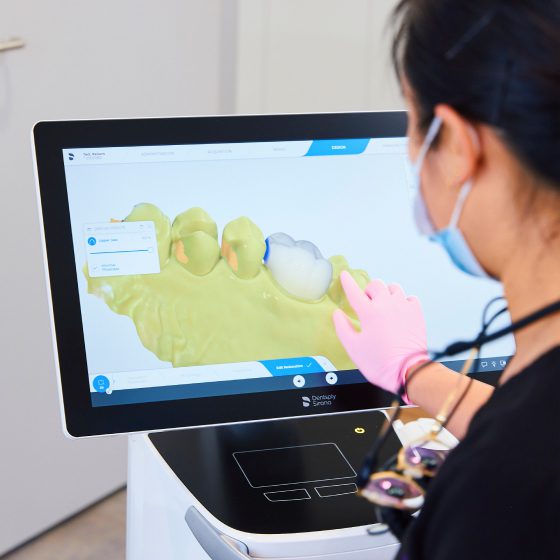Bone grafting for dental implants is a remarkable procedure that has revolutionised modern dentistry. It offers an effective solution for replacing missing teeth due to various reasons such as infection, trauma, severe tooth decay, or gum disease.
Unlike traditional bridges or dentures, dental implants are fixed directly to the jawbone, providing a long-lasting and almost permanent solution. They not only restore the aesthetics and functionality of your smile but also promote bone preservation and create a strong bite that allows you to enjoy your favourite foods with confidence.
In this article, we will explore the science behind bone grafting for dental implants, including when it is necessary, how it is performed, and the benefits it provides.
Understanding Dental Implants and Bone Grafting
What are Dental Implants?
Dental implants are artificial tooth roots made of biocompatible materials like titanium that are surgically placed into the jawbone. These implants serve as a foundation for replacement teeth, allowing them to function and feel like natural teeth. Dental implants offer a more permanent solution compared to traditional tooth replacement options such as bridges or dentures.
The Importance of Bone Grafting for Dental Implants
In some cases, the jawbone may not have sufficient volume or density to support a dental implant. This can occur when teeth have been missing for a prolonged period or due to factors such as gum disease or trauma. Without adequate bone support, dental implants may fail or not last as long as expected.
This is where bone grafting plays a crucial role. Bone grafting is a surgical procedure that replaces and regenerates jawbone volume, creating a solid foundation for successful dental implant placement.

When is Bone Grafting Necessary for Dental Implants?
Bone grafting is necessary for dental implants when the jawbone lacks the necessary thickness, height, or quality to support an implant. Here are some common scenarios where bone grafting may be required:
1. Insufficient Bone Thickness
If the jawbone is too thin or narrow, it may not provide adequate support for a dental implant. This can occur due to factors such as tooth loss, gum disease, or natural bone resorption. In such cases, bone grafting helps build up the bone thickness, creating a stable foundation for the implant.
2. Inadequate Bone Height
Similarly, if the jawbone lacks sufficient height, it may not be able to accommodate the length of a dental implant. Bone grafting can be used to increase the height of the jawbone, providing the necessary space for implant placement.
3. Deficient Bone Around Vital Structures
In some cases, the jawbone may be insufficient around vital structures such as nerves or sinus cavities. This can pose a challenge for dental implant placement. Bone grafting can help augment the bone in these areas, ensuring the implant does not interfere with the surrounding structures.
4. Restoring Bone Loss
Bone loss can occur when teeth are lost and not replaced for an extended period. This can lead to a reduction in jawbone volume and density. Bone grafting can help restore the lost bone, providing a solid foundation for dental implants.
The Bone Grafting Procedure for Dental Implants
The bone grafting procedure for dental implants involves several steps and is typically performed by a specialist surgeon. Here is an overview of the process:
1. Preoperative Evaluation
Before undergoing a bone grafting procedure, a thorough evaluation of the jawbone is conducted using X-rays and computed tomography (CT) scans. These imaging techniques allow the specialist surgeon to assess the volume and condition of the jawbone, determining the need for bone grafting.
2. Surgical Planning
Based on the evaluation results, a surgical plan is developed using advanced 3-dimensional software. This plan takes into account factors such as the location of vital structures, ideal implant sizes and angles, and potential hazards. It ensures precise implant placement and reduces the risk of complications.
3. Anesthesia and Incision
On the day of the procedure, you will be administered local anaesthesia or may undergo conscious sedation or general anaesthesia, depending on your comfort and the complexity of the surgery. Once you are numb and relaxed, the surgeon makes a small incision in your gum tissue to access the jawbone.
4. Graft Material Placement
The bone graft material is then placed in the area where additional bone volume is needed. The graft material can be sourced from your own body, such as your chin, lower jaw, shin, or hip. Alternatively, synthetic bone graft materials, animal bone, or freeze-dried human bone may be used. The choice of graft material depends on factors such as availability, suitability, and your preferences.
5. Graft Integration and Healing
After placing the bone graft material, the surgeon carefully closes the incision with stitches. Over time, the graft material integrates with the existing bone, creating a strong and stable foundation for the dental implant. The healing process can take several months, during which the bone remodels and fuses with the graft material.
6. Implant Placement
Once the bone graft has fully integrated and healed, the next step is to place the dental implant. This is a separate procedure performed after the bone grafting site has sufficiently matured. The implant is surgically inserted into the jawbone, where it will osseointegrate, or fuse, with the surrounding bone.
7. Implant Restoration
After the implant has successfully integrated with the jawbone, a process that usually takes a few months, the final step is to restore the implant with a dental crown, bridge, or denture. This restoration closely resembles a natural tooth and provides functionality and aesthetics.

Benefits of Bone Grafting for Dental Implants
Bone grafting for dental implants offers numerous benefits, including:
1. Improved Implant Success Rate
By creating a solid foundation for dental implants, bone grafting significantly improves the success rate of the implant procedure. It ensures that the implant can be firmly anchored in the jawbone, reducing the risk of implant failure.
2. Enhanced Bone Preservation
Bone grafting helps preserve the jawbone by preventing further bone loss. When a tooth is lost, the surrounding bone can deteriorate over time. By grafting bone into the area, the bone volume and density are maintained, preserving the overall oral health and aesthetics.
3. Optimal Aesthetics and Functionality
Bone grafting provides a stable and secure platform for dental implants, allowing for optimal aesthetics and functionality. The implants blend seamlessly with the surrounding teeth, creating a natural-looking smile. Additionally, the strong bite force achieved through implants enables patients to enjoy a wide range of foods without discomfort or limitations.
4. Long-lasting Results
With proper care and maintenance, dental implants placed on a solid foundation of bone grafting can last a lifetime. Unlike traditional tooth replacement options, such as bridges or dentures, dental implants are a more permanent solution that does not require frequent adjustments or replacements.
Is Dental Bone Grafting Right For You?
With the advancements in bone grafting techniques and materials, dental implants have become a reliable and effective solution for replacing missing teeth and restoring your smile.
By understanding the science behind bone grafting and its significance in dental implant surgery, you can make an informed decision and achieve the smile they desire.
If you are considering dental implants, contact our team at the Melbourne Dental Implant & Sleep Centre. Our specialist dental implant surgeons will discuss your needs to determine if bone grafting is necessary for your individual case.
Call us today on 1800 IMPLANT to book an appointment and take the first steps on your implant journey.

